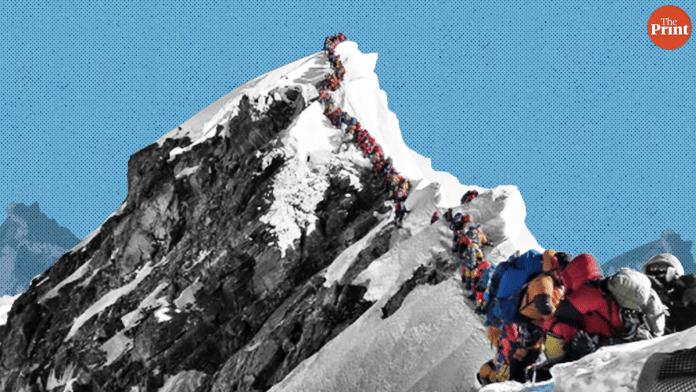At least 11 people, including three Indians, have died on the Mount Everest this year with overcrowding at the highest peak proving to be a major concern. Mountaineers have blamed inexperienced climbers as well as operators for the traffic jam. Last week, a picture of a long queue of mountaineers waiting to climb the peak went viral.
ThePrint asks: Everest traffic jam: Has climbing the highest mountain in the world lost its charm?
This episode has shown that Everest still can’t be tamed, which will make it even more appealing
 Kenton Cool
Kenton Cool
Leading high-altitude climber, has summited Mount Everest thirteen times
Despite the media attention around crowding and deaths on Everest over the last week, I truly believe that the mountain hasn’t lost its charm. All that it’s done is shown the world that even with modern technology and equipment, she still can’t be tamed and that will potentially make the mountain even more appealing. The sad matter is that some of the deaths could have been avoided and the crowding took away from what should have been an achievement of a lifetime for many.
During my career on the mountain over the last 15 years, I have seen many things, including crowds, but I have never been caught up in them. I guide on the mountain in a bespoke way, leading small agile teams. We can take advantage of small weather windows that the bigger, more unwieldy teams can’t; we can move fast on the hill and be flexible in our decision making; the sherpa team is strong with multiple summits each; and, above all, we have a plentiful supply of oxygen. The whole team is tailored for maximising safety and enjoyment for the client.
The pictures in the media sadden me and pour scorn on my beloved mountain but ask any of my clients and they will all say the same thing — that they had an adventure of a lifetime during their experience on Everest.
My message to your readers is a simple one: chose your team carefully, but more than that, make sure you are ready to go. Gain the experience that you need on other mountains so that when you go to the Everest, you deserve to be there rather than rely on others to make the critical decisions for you.
Mountaineers, most of whom are amateurs who can’t tie their boots, need to shed ‘herd mentality’
 Kuntal Joisher
Kuntal Joisher
Vegan mountaineer
Mount Everest is the highest mountain in the world, and mountaineers will always be tempted to climb it regardless of the number of mishaps that might take place. So, the charm of Mount Everest isn’t ever going to die.
That said, the traffic jam that occurred at Mount Everest is a sign of herd mentality among the many climbers. When they saw a small window of opportunity with good weather condition on 22 May, they decided they must all flock to the mountain the same day.
The issue points towards a greater problem of lack of leadership. None of the team leaders thought it fit to postpone their summit to later in the week. What added to the problem was the fact that authorities had issued 400 permits for climbers.
Moreover, many of the climbers are amateurs — they even lack the skills to tie their boots. For them, it isn’t the dream of climbing the Everest that motivates them, but the sheer recognition they will receive from their governments back home. If someone is planning to climb the Mount Everest, they need to come prepared for all kinds of situations.
Also read: Everest tourism is causing a mountain of problems every year
Issuing more permits was not an issue; it’s the small window of clear weather that caused the traffic jam
 Karma Tenzing
Karma Tenzing
Owner, Into The Himalaya Treks and Expedition
A record 381 climbing permits were issued for Everest in 2019, as against 347 in 2018 and 375 the year before. However, unlike last year’s week-long clear weather window for the climbers to plan their summit bid, there was only 4-5 days (15-16 May and 21-23 May) of suitable weather conditions this year.
My team at ‘Into The Himalaya’ summited on 15 May, the first day of the window, when there was no jam and we remained there for an hour. The Seven Summit Treks team summited on 16 May — again, without any “traffic jam”. But most of the 381 Sherpas and clients heading into the mountains tried to summit within that small window of 3-4 days. This caused a rush on 22-23 May.
It would have been better had other companies tried to get their clients up during the first two-day window. I don’t see permits being an issue since the number of permits issued this year was only six more than in 2017. It’s the weather window that caused the jam.
Legendary Kami Rita Sherpa, who summited Everest for the 24th time this season, also said that the “traffic jam” was not the issue. Also, when I hear about people running out of oxygen, it’s more an issue of them being ill-prepared in their attempt to climb the world’s most dangerous and highest mountain.
Everest today is less of a mountain and more of a commercial enterprise with all the drawbacks
 Suman Dubey
Suman Dubey
Former journalist and member, second Indian expedition to Mount Everest in 1962
For more than a hundred years, Mount Everest, the world’s highest mountain, was revered, respected and held in awe, not just by those who lived around its base, but also by those who came to climb it. Its exploration in the early part of the 20th Century was the stuff of epics. It attracted human endeavour at its best and its first ascent in 1953 was celebrated around the world as the crossing of a frontier in human courage and daring.
Today, it’s become a symbolic measure of the heights human folly can achieve. The pictures of long queues clinging to icy ramparts or narrow ridges, the tonnes of garbage and of dead bodies littering its slopes, the large sums of money involved in climbing it – this isn’t the sport of mountaineering. It isn’t even fun. And how can it be satisfying when it is so dependent on the skill and hard work of others, professionals who prepare the route and hand-hold their clients every step of the way?
Everest was never an easy mountain to climb because it is vast and requires an enormous logistical effort. But today, it is less a mountain and more a huge commercial enterprise. And it has all the drawbacks of an unregulated, profit-driven activity. Every now and then, like it did this this year, Mount Everest sends out a warning, and people die in large numbers. But it deserves better, it deserves to regain the reverence and respect that nature demands of us. The mountains are more than mere rock and ice waiting to be tamed by human vanity. It is for those responsible for its management to work out how, but unless there’s better regulation of numbers and better care for its environmental health, the direction Everest is now headed towards will remain downhill for sure.
Also read: Organisation of mountaineers demands restriction of Mt Everest permits
Advanced technology and accurate weather forecast system have in fact caused the crowds to swell
 Yubaraj Ghimire
Yubaraj Ghimire
Senior Kathmandu-based journalist
Everest expedition season that lasts for three months ending 31 May saw 44 groups consisting of 381 climbers trying their luck this year.
The figure has remained more or less in the same range but the success rate varies, because permits are granted on a first-come-first-served basis, according to the authorities.
Adverse publicity about relatively higher casualty this year (altogether eleven, out of which three were Indians) and lack of cleanliness along the expedition route have come as a big shock to general public. But organisers say they charge US $4,000 per person as deposit, which is returned only after they verify that they did not contribute to the garbage.
There is no apparent evidence of declining charm to scale the highest peak in the world. In fact, advanced technology and accurate weather forecast system have contributed to the swelling crowds on certain favorable days of the season.
The passion of the climbers, availability of canned oxygen, and the added meaning that summit journey carries in the corporate world continue to lure many climbers.
By Fatima Khan, journalist at ThePrint.







There is something iconic about the photograph of the traffic jam on path to Mt. Everest; a kind of shock value. Prompts me to recall my numerous treks with a couple of college friends in 1980s – to Roop Kund, Sunderdhunga glacier, Milam glacier etc in Utarakhand – on which we hardly came across trekkers except an odd one or two small groups (mostly Bengalis). On a recent hike to Triund (above McLeodganj) – which was a first climb in the wild for my wife – it was pure solitude for most of the stretch.
The photograph takes away something from the solitary splendour of this majestic mountain. A special prayer for all those who have perished this season.